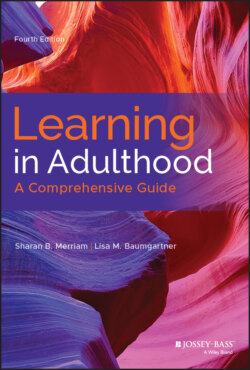Читать книгу Learning in Adulthood - Sharan B. Merriam - Страница 58
Part II Adult Learning Theory
ОглавлениеThe accumulation of information and experiences grounded in practice often leads to thinking about how the parts of what we know might fit together to form some sort of explanatory framework. In Part II of Learning in Adulthood, we review a number of attempts to explain adult learning. Some of these efforts, as in the work on self-directed learning, are tentative frameworks for ordering research—that suggest future directions for theory. Other efforts can properly be labeled models, if we define model as a visual representation. A theory, which may have a model accompanying it, is a set of interrelated concepts that explain some aspect of the field in a parsimonious manner.
We begin Chapter 5 with a discussion of Knowles's (1980) concept of andragogy, which he originally termed a theory of adult learning. Probably the best-known set of principles or assumptions to guide adult learning practice, andragogy actually tells us more about the characteristics of adult learners than about the nature of learning itself. The first half of the chapter is devoted to a thorough review and critique of andragogy. Also reviewed in Chapter 5 is McClusky's (1970) theory of margin, a theory that resonates with adult learners, perhaps because the theory considers adult learning in relation to other activities of adult life.
Since Tough's work on adult learning projects was published in 1971, self-directed learning and individual learning projects have captured the imagination of researchers and educators across the lifespan and from all areas of education. Although learning on one's own is the way most adults go about acquiring new ideas, skills, and attitudes, this context has often been regarded as less important than learning that takes place in more formal settings. Chapter 6 discusses three types of models—linear, interactive, and instructional—developed to describe the process of learning when that learning is primarily managed by the learners themselves. Most adults use more of an interactive model in that they do not necessarily plan what, how, or when they want to learn. Scholars have also focused on studying self-direction as a personal attribute of the learner. Two ideas that have received the greatest attention in this approach are the notion of readiness for self-directed learning and the concept of autonomy. The chapter concludes with a review of the major issues researchers need to address in building future research agendas in self-directed learning.
Changes in cognition and consciousness constitute the focus of transformational learning reviewed in Chapter 7. Mezirow's (2000) perspective transformation and Freire's (1970) conscientization contend that changes in perspective or consciousness are the defining characteristic of learning in adulthood. Mezirow's theory in particular has stimulated considerable debate and research during the past 10 years. Using Taylor's (2008) “lenses” for organizing the literature on transformational learning, the first half of the chapter reviews the various theoretical bases for transformational learning. Also examined are three concepts key to understanding transformative learning: the centrality of life experience, the nature of critical reflection, and the connection between transformative learning and adult development. We then discuss the extent to which transformative learning theory takes context into account, the role of emotions and relationships, the place of social action, and the educator's role in facilitating transformative learning. In the last chapter of Part II we explore the role of experience and learning, which has a long legacy in the writings on adult learning. Discussed first in the chapter are representative theories that offer varying conceptual views of the process of learning from experience, including the foundational work of Dewey (1938) and Kolb (1984), and the contemporary work of such scholars as Jarvis (2001), Boud and Walker (1991), Fenwick (2003), and Usher, Bryant, and Johnston (1997). Although the focus of this work has been on individual learners, in recent years there has been a shift to understanding how the context affects learning and how it is an integral component of the learning process. We then describe reflective practice, one of the primary ways in which educators have structured learning from experience. We conclude the chapter with an overview of situated cognition and descriptions of two instructional approaches—cognitive apprenticeship and anchored instruction—that are based in situated cognition, stressing how “authentic experiences” grounded in real-life situations are viewed as key components in operationalizing this concept.
